Essential Guide for Beginner Surfers in Oahu
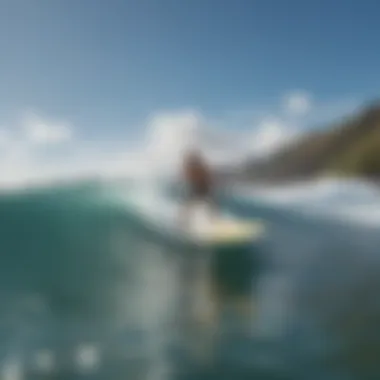
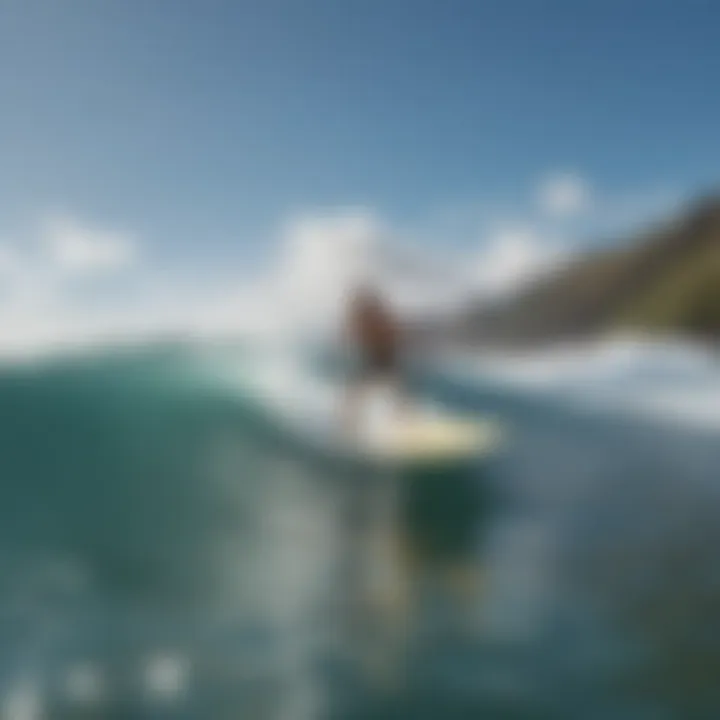
Intro
Oahu, often referred to as the heart of surfing, offers a unique blend of breathtaking landscapes and some of the best waves in the world. For those stepping onto a surfboard for the first time, this island can feel both inviting and daunting. Just like riding a bicycle, surfing demands balance, coordination, and a certain degree of fearlessness. It's not just about hopping on the board, but understanding the surrounding ocean dynamics, safety measures, and equipment.
This guide aims to arm novice surfers with all the know-how they need to enjoy their wave-riding adventure safely. From figuring out the right surfboard to mastering the basics, and from learning about the local surf spots to understanding surf etiquette, this article covers everything you need to know. With a focus on accessible information and real-world insights, we hope to make your journey into surfing as smooth as a calm sea on a summer's day.
Surfboard Reviews
Types of Surfboards: An Overview
For beginners, the world of surfboards can be overwhelming. Various shapes and sizes cater to different styles, skill levels, and wave conditions. Here’s a closer look at some board types:
- Shortboards: Typically between 5 to 7 feet long, these boards are designed for performance. They allow quick turns and maneuverability but may not be ideal for beginners who prioritize stability.
- Longboards: These can range from 8 to 12 feet, offering greater buoyancy and stability. Longboards make it easier to paddle out and catch waves, making them perfect for novices.
- Funboards: Also called fish or mini-mal boards, they sit between shortboards and longboards in terms of size. Funboards have more volume, allowing for easier paddling while still offering some responsiveness.
Each board type offers unique advantages. Choosing one that matches your skill level and the type of waves you’ll be riding is crucial.
Best Surfboards for Beginners and Pros
Selecting the right surfboard can make or break your initial experiences in Oahu’s waves. Below are some recommendations encompassing various styles:
- Soft-Top Boards: Recommended for absolute beginners. They are wider, have rounded edges, and are generally lighter, making them forgiving on falls. A popular choice here would be the Wavestorm Soft Top.
- Mid-Length Boards: As you build confidence, a mid-length board, like the Torq Retro Fish, can serve as a fantastic transition. Their stability and versatility are beneficial as you start to explore different conditions and maneuvers.
- Performance Shortboards: Once you've mastered the basics and are ready to tackle more challenging waves, boards like the Channel Islands Proton can enhance maneuverability and performance.
In summary, the choice of a surfboard should hinge on personal comfort and the surf conditions you anticipate. A board that fits well can boost your confidence on the water, reducing the chances of wipeouts.
Surfing Techniques
Essential Techniques for Beginners
Mastering the fundamentals is an essential stepping stone in learning how to surf. Beginners should focus on:
- Paddling: Effective paddling requires using your arms in a synchronized manner while keeping your body horizontal on the board.
- Pop-Up: This motion is critical for getting up from lying down to standing. Practice transitioning swiftly from your chest to your feet in one smooth motion.
- Ducking Under Waves: Learn to maneuver through incoming waves by positioning your hands on the board and pushing it under as larger waves approach.
Advanced Maneuvers for Experienced Surfers
Once you've got the basics nailed down, consider refining your skills with more advanced techniques:
- Cutbacks: This involves turning back towards the whitewater after reaching the peak of a wave, enhancing your ride.
- Aerials: These moves are about catching air off the lip of a wave. This requires not only skill but also an understanding of wave dynamics.
Great surfers are always evolving their skills. Regardless of your level, always aim to learn and improve. That dedication will reflect in your surfing journey, making it both fulfilling and enjoyable.
"Surfing is much more than a sport; it’s a way to connect with nature, learn respect and patience, and soak in the beauty of the ocean."
Mastering the waves on Oahu requires practice, determination, and a willingness to learn. Remember to respect the locals and the ocean, and you'll find yourself not just surfing, but riding the waves of life.
Prolusion to Surfing in Oahu
Surfing in Oahu isn't just a sport; it's a way of life. Nestled in the majestic Hawaiian Islands, Oahu has become synonymous with the surfing lifestyle, attracting enthusiasts from around the world. For beginners, understanding the ins and outs of this water-based adventure is crucial. There’s a certain rhythm to the waves here, and with the right guidance, anyone can learn to dance with them.
Oahu’s unique blend of stunning beaches, diverse surf spots, and vibrant surf culture makes it an ideal starting point for novice surfers. This article aims to illuminate the essential aspects of surfing, allowing beginners to navigate their journey with confidence. The key elements we will discuss include the historical roots of surfing in Oahu, the significance of the island as a premier surfing destination, and practical tips to kickstart your surfing adventure in these beautiful waters.
Historical Context of Surfing in Oahu
Surfing traces its roots back to ancient Polynesian culture, and Oahu holds a prominent place in this history. The sport was not merely a pastime; it served as a social and spiritual ritual. Kings and commoners would surf together, showcasing strength, skill, and connection to the ocean, embodying a lifestyle that revolved around respect for nature.
"The ocean is the greatest teacher. You learn a lot about life while you ride the waves."
In the early 20th century, surfing was revitalized through figures like Duke Kahanamoku, who introduced the sport internationally. Duke wasn't just a champion swimmer; he was a cultural ambassador. His passion for surfing helped propel Oahu onto the global stage. Festivals and competitions are now commonplace, showcasing both the sport's rich history and its modern-day evolution.
Significance of Oahu as a Surfing Destination
What sets Oahu apart from other surfing locales? It’s a tapestry of surf experiences, catering to everyone from greenhorns to seasoned pros. The island is home to famed North Shore spots like Waimea Bay and Pipeline, renowned for their towering waves during winter months, while the southern shores, like Waikiki, offer gentler waves ideal for beginners.
Additionally, Oahu’s supportive surf community plays a significant role. Local surfers often welcome newbies, imparting wisdom and fostering a sense of camaraderie. This culture not only enhances the learning experience but also encourages a deep respect for the ocean and its waves. Many surf schools dot the coastline, offering trained instructors who help beginners build foundational skills while prioritizing safety.
As one dives deeper into the surfing experience in Oahu, it’s clear that the ocean here is more than just a playground; it’s a living lesson, a community hub, and a testament to a wave-riding heritage that continues to thrive.
Understanding Basic Surfing Terminology
Understanding the terminology associated with surfing may seem trivial at first, but it’s actually quite crucial for beginners diving into this vibrant sport. Terminology acts as the common language among surfers, helping to communicate effectively both in the water and on the shore. Now, having a handle on these terms will not only enhance one’s learning experience but also foster a sense of camaraderie within the surfing community. When you’re chatting with fellow surfers, understanding their lingo can help you feel like one of the crew.
Let's break it down further, with the two primary subsections highlighting key terms and how to read surf reports effectively.
Common Terms Every Beginner Should Know
Here are some essential terms that beginners should familiarize themselves with:
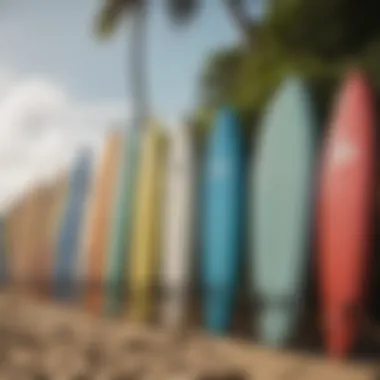
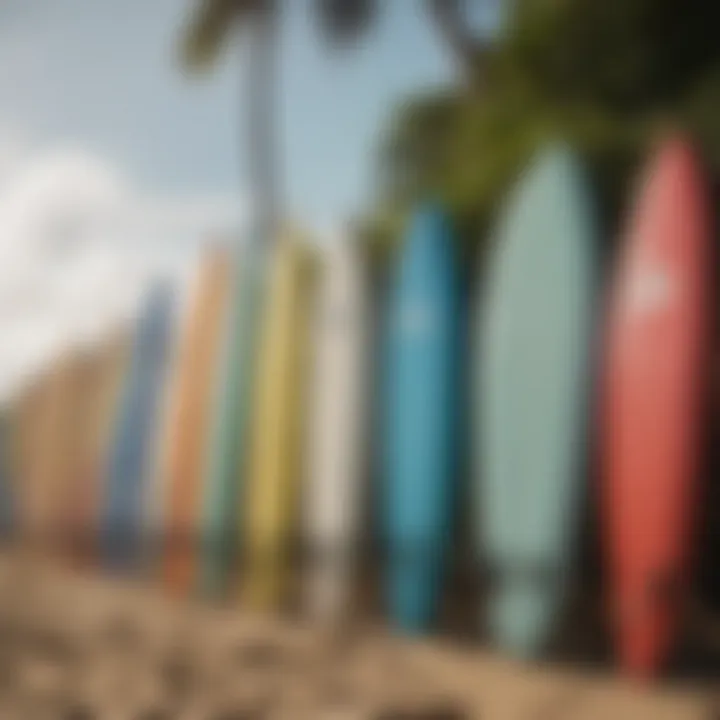
- Wave: The most important feature in surfing, waves are created by the wind pushing water, resulting in swells.
- Break: This refers to the way a wave peaks and collapses. Understanding where the wave breaks is key to catching it.
- Pop-Up: This term indicates the action of transitioning from lying down to standing on the surfboard, an essential skill for any surfer.
- Line-Up: The area in the water where surfers wait for the right wave to catch. Knowing how to position yourself here is paramount.
- Wipeout: This is what happens when a surfer falls off their board, often accompanied by the rush of splashing water.
- Set: A group of waves that come in at the same time. Recognizing sets is crucial for timing your catch.
It becomes easy to see that these terms not only define aspects of surfing but also contribute to safety and enjoyment out on the waves. Being able to communicate these concepts helps you understand the dynamics of the surf and work more effectively with instructors or fellow surfers.
Reading Surf Reports and Forecasts
Surf reports and forecasts are indispensable tools for making the best of your surfing experience. When using these resources, there are a few key elements to consider:
- Wave Height: This indicates how tall the waves are expected to be, crucial for knowing what conditions to expect.
- Wind Conditions: Wind speed and direction can significantly affect wave quality. Offshore winds usually mean better waves.
- Tide Information: The state of the tide (high or low) impacts how waves break at particular spots, affecting their rideability.
- Swells: Look out for information about swells. Consistent swells from the ocean can produce better surfing conditions than choppy ones.
"Checking surf reports daily not only keeps you informed but can greatly enhance your surfing experience, ensuring you're out there when conditions are prime."
When reading surfing forecasts, understanding these elements can make a day of surfing enjoyable or frustrating. Familiar synonyms can often be misleading, but being well-versed in this specific terminology can lead you to make safer and smarter decisions about your outings.
A good starting point for finding surf forecasts is to check local surf shops or reputable surfing websites, where the lingo is often explained alongside the reports.
In a nutshell, mastering basic surfing terminology lays a solid foundation for your surfing journey. The more informed you are, the easier it becomes to learn and enjoy the art of surfing.
Choosing the Right Surfboard
Selecting the right surfboard can make or break your experience as a beginner surfer. This choice, though it may seem straightforward, involves a myriad of considerations that can contribute significantly to your progress on the waves. A well-chosen surfboard not only enhances your learning curve but also fosters confidence as you ride the waves. With countless options available, understanding the different types, sizing, and purchasing strategies becomes essential for anyone looking to dive into the world of surfing.
Types of Surfboards Best for Beginners
As a novice, it’s beneficial to lean towards a surfboard that’s forgiving and easy to maneuver. Here are some types that stand out:
- Soft-top Surfboards: These boards are perfect for learners. Their cushioned surface reduces the likelihood of injuries during wipeouts, which is a common occurrence for newcomers. Moreover, their buoyancy makes catching waves easier.
- Longboards: If you prefer a more stable ride, longboards might be your buddy. They provide excellent balance and are generally slower, which allows beginners time to find their footing before they try faster maneuvers.
- Funboards: This type is a happy medium between longboards and shortboards. They have a wider shape and a shorter length than longboards, granting beginners the stability they need without compromising too much on performance.
Choosing the right type hinges on your comfort level and the wave conditions in Oahu.
Surfboard Sizing and Specifications
When selecting a surfboard, size matters—a lot. The typical guideline for beginners is to look for a board that reaches about your chest or chin level when stood up.
Here are key factors to base your sizing on:
- Length: Longer boards tend to offer greater stability, making it easier to stand up and balance. If one is under 5’2", a board between 7’ and 9’ in length works well.
- Width: A wider board provides more surface area, which translates to better stability. You should typically aim for a board that’s at least 20 inches wide.
- Thickness: Thicker boards float better, helping you paddle out and catch waves with less effort. Look for a thickness of around 2.5 to 3 inches for that extra buoyancy.
These specifications align with both physical attributes and personal preferences, so taking time to consider your choices is worthwhile.
Tips for Purchasing and Renting Surfboards
Navigating the board-buying process can feel like uncharted waters, but keeping a few tips in mind can steer you in the right direction:
- Check Local Shops: Many surf shops in Oahu offer rental options. This is a great way to test different boards before making a hefty purchase.
- Look for used boards: Often, beginners may feel hesitant about spending a fortune on a new board that they might outgrow quickly. There are high-quality used boards on platforms like Facebook Marketplace that won’t break the bank.
- Seek Advice: Don’t hesitate to consult local surf instructors or fellow surfers. They can offer valuable insights based on their experiences and the specific conditions in Oahu.
- Inspect the Board: Whether renting or buying, always inspect for dings, cracks, or repairs. A hidden defect can quickly turn your surfing adventure into a frustrating ordeal.
In choosing wisely, you’re setting yourself up for success, ensuring that you stay afloat in your surfing endeavors.
"Choosing the right surfboard is akin to selecting the right companion for a journey. With the right board, those waves will feel like home."
By understanding the different types and sizing of surfboards and approaching the purchasing process wisely, you're poised to embrace the unforgettable journey of learning to surf in Oahu.
Finding the Ideal Surf Spot in Oahu
Finding the right surf spot in Oahu is a vital component of the surfing experience. Surf conditions can vary greatly depending on specific locations, and understanding these variations can significantly enhance learning for beginners. Choosing the wrong spot could lead to unnecessary challenges or even dangerous situations. The beauty of Oahu lies not only in its picturesque landscapes but also in its diverse wave patterns.
When novice surfers land on a beach like Waikiki, they might think all waves are created equal. However, each location has its own unique characteristics.
Popular Surfing Locations for Beginners
Some of the most favored surf locations for beginners include:
- Waikiki Beach: Known across the globe, the gentle waves here are perfect for those just starting out. The long, rolling swells provide ample time to catch a wave without feeling overwhelmed.
- Canoes: Located at Ala Moana Beach Park, Canoes offers soft, friendly waves that are straightforward to ride. The easy access makes it a popular spot among those new to surfing.
- Kailua Beach: This spot is often less crowded than Waikiki but still provides favorable conditions for beginners. The clear waters and soft waves ensure a fun learning environment.
- Lanikai Beach: Known for its beautiful scenery, Lanikai also offers consistent and manageable waves, making it an excellent choice for a practice session.
"Selecting the right surf spot can make the difference between a successful day on the waves or going home frustrated."
These beaches not only serve as suitable learning hubs but are also equipped with nearby amenities like surf schools and rental shops, making surfboard access easier for newcomers.
Evaluating Surf Conditions: Waves, Tides, and Currents
Understanding how to assess wave conditions, tides, and ocean currents is crucial for any beginner surfer. Here’s a breakdown of what to keep an eye on:
- Waves: Beginners should look for smaller waves, generally below waist height, as these are easier to paddle for and ride. The general rule is to start learning on rolling waves rather than steep or powerful ones.
- Tides: The tide can greatly affect wave quality. For example, some spots work better during high tide, while others become more suitable at low tide. Knowing the local tide patterns helps surfers plan their sessions more effectively.
- Currents: A basic understanding of rip currents is vital. If you find yourself drawn out to sea, stay calm and swim parallel to the shore until you’re out of the current. This knowledge will ensure that your time surfing remains enjoyable and safe.
Ensuring safety while enjoying the thrill of surfing aids in cultivating a passion for the sport. By evaluating these elements, beginners can select the best surf spot that aligns with their skill level.
Selecting a Surf School or Instructor
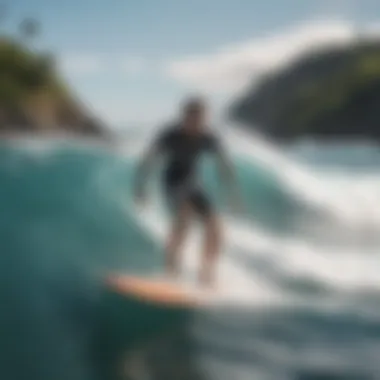
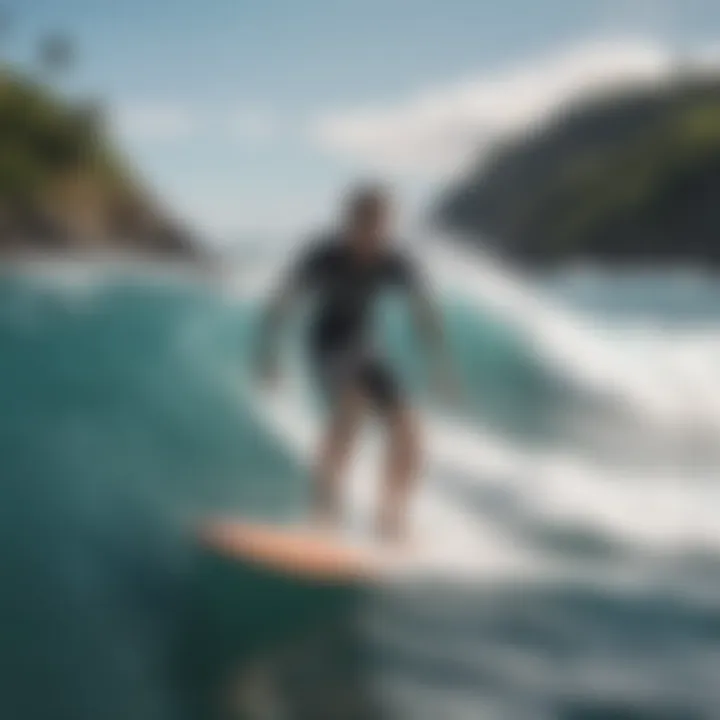
Finding the right surf school or instructor can make all the difference in your surfing journey. This step is crucial, especially for beginners who need a solid foundation to build upon. With the right guidance, you’ll learn the ropes faster, avoid bad habits, and gain confidence on the waves. Moreover, surfing is not just about learning techniques; it also involves knowing the ocean’s moods, safety protocols, and respect for the environment. Thus, choosing a school with a strong emphasis on these aspects is essential.
Criteria for Choosing a Reputable Surf School
When selecting a surf school, there are several key criteria to keep in mind:
- Instructor Qualifications: Check the credentials of the instructors. Not all great surfers are great teachers. Look for schools that employ certified instructors with extensive experience in teaching beginners. They should also be trained in CPR and first aid to ensure your safety surfacing.
- Student-Teacher Ratio: A lower student-to-instructor ratio means more personalized attention. Ideally, one instructor should manage only a few students at a time, allowing for tailored guidance and feedback.
- Reviews and Reputation: Look for schools with positive reviews on platforms like Facebook or Reddit. Word of mouth from previous students can provide insights that flashy ads might not disclose. Consider joining local surfing groups to ask for recommendations.
- Equipment Quality: A good surf school should offer well-maintained boards and wetsuits suitable for your skill level. Poor equipment can hinder your learning experience.
- Safety Protocols: Ensure the school has clear safety measures in place. They should provide safety briefings before heading out into the water, outlining potential risks and how to avoid them.
- Flexible Class Options: Look for schools that offer different classes, such as private lessons, group classes, or even workshops focusing on specific skills. This flexibility allows you to choose what works best for you.
Choosing the right surf school involves doing your homework. Take your time to research, ask questions, and gauge your options before diving in.
What to Expect from a Beginner Surf Lesson
As you prepare for your first surf lesson, it’s helpful to know what to anticipate:
- Warm-Up and Safety Briefing: Most lessons kick off with a warm-up session to get your body ready. Instructors often use this time to discuss safety protocols, wave conditions, and the surf environment.
- Basic Theory: Before hitting the waves, expect a brief overview of the surfing fundamentals. This might include learning how to paddle, how to position yourself on the board, and understanding the types of waves you will encounter.
- Hands-On Practice: After the theory, it’s time for action. Your instructor will assist you in getting on the board, teaching you how to pop up and ride a wave. Don’t be surprised if you find yourself falling a lot! It’s just part of the learning curve.
- Feedback and Tips: Expect constructive feedback from your instructor throughout the lesson. They might suggest adjustments to your technique or help you learn how to read the waves better.
- Cool Down and Wrap-Up: Most lessons will conclude with a cool down. This is your chance to ask questions, reflect on what you’ve learned, and look ahead to your future sessions.
Remember, every surfer’s journey is unique. While it’s normal to feel overwhelmed at first, embrace the process. Keep a positive outlook, and you’ll find yourself improving before you know it!
By understanding what to expect, you’ll walk into your first surfing lesson feeling prepared and excited to catch some waves.
Mastering Basic Surfing Techniques
Mastering basic surfing techniques is the linchpin for those who are just starting their surfing journey in Oahu. It’s vital not just for catching waves but also for ensuring safety and enjoyment in this thrilling sport. The ocean can be unpredictable, and understanding how to maneuver effectively on the board can significantly boost a beginner’s confidence and ability. Practicing these techniques allows surfers to respond better to changing wave conditions and to become more in tune with the ocean itself.
Learning How to Paddle Efficiently
Paddling might seem straightforward, yet it’s one of the most important skills a beginner can develop. Efficient paddling enables surfers to position themselves correctly in the water and catch waves when the opportunity arises. Start by lying flat on your board, positioning your body towards the tail, and keeping your feet close together. Try to keep your head low because it helps maintain balance and drag resistance in the water.
To paddle effectively, use a smooth, alternating arm stroke; each pull should be deep and powerful, as though you’re slicing through water. Embrace the rhythm: "two strokes right, one left" is a good mantra to keep yourself steady. Not only does good paddling help you navigate to the best spots, but it also builds stamina and gets you a bit fitter too. Remember, practice makes perfect, so don't shy away from the water!
Pop-Up Technique: How to Stand on the Board
The pop-up technique is crucial for moving from lying down to standing on the board. Successfully executing this maneuver can be the difference between riding the wave like a pro and belly-flopping back into the surf. Start this process on land before trying in the water. Place your hands beneath your shoulders, push your upper body up like a yoga cobra pose, and in a quick motion, swing your feet under you and land on the board in one fluid movement.
Timing is everything; the sooner you can stand after catching the wave, the better your chances of maintaining control. A big tip: work on your speed. The longer you take to stand, the more likely you are to wipe out. It might feel awkward at first, but repetition will carve these movements into your muscle memory.
Navigating Waves: Timing and Positioning
In surfing, timing and positioning can seem like an art form. It’s not just about being in the right spot; it’s understanding when to be there. As a beginner, learning to read the waves is essential. First, observe the waves from a distance—notice their patterns and how they break.
When the wave approaches, align yourself so that you can catch it just as it begins to crest. This requires a keen sense of timing; practice this by watching others at the beach. You’ll often hear seasoned surfers talk among themselves about being “in the zone” or “on the pulse” of the waves. Think of it like dancing with nature; once you understand the rhythm, it becomes far more rewarding.
Important Tip: If the wave seems too big, it’s better to back off and wait for a smaller one. Respecting the ocean and knowing your limits is key to a safe surfing experience.
In summary, mastering these basic techniques is not merely about performance; it elevates the entire surfing experience. As you learn to paddle, pop-up, and navigate waves correctly, you begin to foster a deeper respect for the ocean, which is the core of the surfing ethos.
Safety Considerations for Beginner Surfers
Safety is paramount in any water sport, especially when it comes to surfing. For beginners diving into the waves of Oahu, understanding the various safety considerations is not just a guideline—it's a necessity. Whether you're an enthusiastic learner or a cautious adventurer, taking the time to grasp these concepts can make all the difference in ensuring a fun and accident-free experience.
Understanding Ocean Hazards
The ocean can be a beautiful yet unpredictable friend. Knowing the hazards before paddling out is essential for every beginner surfer. Here are several factors to keep in mind:
- Rip Currents: These fast-moving bodies of water can catch even the most experienced surfers off-guard. They flow away from the shore and can be found in various spots along the coast. It’s crucial to identify areas where rip currents are prevalent. If caught in one, swim parallel to the shore until the force diminishes, then head back in.
- Large Waves: Oahu is known for its powerful waves. Beginners should be cautious, especially during peak surf seasons. A wave that looks inviting can quickly shift in size and intensity.
- Marine Life: Encounters with marine animals can be thrilling, yet sometimes dangerous. While most sea life is harmless, it’s wise to be mindful of jellyfish and sharp corals. Wearing protective gear can help prevent injuries.
"Stay aware of your surroundings and don't hesitate to take a moment to observe the ocean before you jump in," says local surf instructor Koa. This simple advice can save you from sticky situations.
Essential Surfing Etiquette
Respect and courtesy go a long way in the surfing community. Learning the unwritten rules not only keeps you safe but also fosters a positive environment at the surf spot. Here are key points of etiquette for beginners:
- Right of Way: The surfer closest to the peak of a wave has the right of way. If you’re further down the line, give way to the person ahead of you.
- Avoid Dropping In: This is when a surfer catches a wave that another surfer is already riding. Not only is it considered bad manners, but it can also lead to collisions and injuries.
- Paddle Around: If you fall off your board, paddle back around the wave instead of directly through it to prevent risking collision with others.
- Respect Local Surfers: Oahu has a rich surf culture. Being courteous to local surfers and acknowledging their presence can create good vibes. Remember, a smile can go a long way!
Whether you're out there to ride the waves or just to enjoy the beauty, ensuring safety and practicing etiquette will make your surfing experience not just safer, but also more enjoyable. Familiarize yourself with the local surf scene and invest time in understanding the nuances; it will pay off in leaps and bounds.
Embracing the Surfing Community
Surfing isn’t just about catching waves; it’s also about the people you meet along the way. The surfing community in Oahu is vibrant, welcoming, and, above all, passionate. Embracing this community can make your surfing journey much richer and more enjoyable. From sharing tips on the best surf spots to lending equipment, connecting with fellow surfers can create bonds that extend beyond the water. The sense of belonging in this community is palpable and can help beginners feel more comfortable as they navigate the learning curve.
Connecting with Local Surfers and Groups
Getting involved with local surfers can be a game-changer for anyone starting out. When you’re surrounded by experienced surfers, you naturally pick up on their skills and tips. Plus, many local surfers love to share their knowledge about Oahu’s unique surf conditions. Joining local groups can provide a sense of camaraderie and promote safety in the water.
- Join Surf Clubs: Clubs often host regular meet-ups and events. They provide an organized way to connect with like-minded individuals who share your passion.
- Engage on Social Media: Platforms like Facebook often have local surfing groups where members post about surf conditions, share experiences, and organize trips.
- Attend Local Events: Many communities hold fun events or gatherings, which can be a perfect opportunity to meet seasoned surfers.


It’s worth noting that locals are usually keen on welcoming newcomers, as long as you respect the ocean and their surfing spots. A simple smile or wave can open doors to friendship.
Participating in Surf Events and Competitions
Diving into surf events is another excellent way to embrace the community. These events range from casual gatherings to competitive heats, providing an opportunity for all levels of surfers.
Engaging with surf events can offer several benefits:
- Learn New Techniques: Watching experienced surfers in action during competitions can teach you a great deal.
- Gain Exposure: Participating shows your commitment, and you may find mentors eager to guide you.
- Build Relationships: Events foster a sense of community and belonging, where friendships can blossom.
Key events to consider include:
- Local Surf Contests: Some are strictly for beginners while others feature more experienced surfers. You may even find fun events where you can participate without the pressure of competition.
- Beach Clean-Up Events: Not strictly surfing-related, these gatherings promote sustainability and show respect for the ocean.
- Workshops and Clinics: Look out for organizations hosting workshops that focus on improving specific skills or techniques.
Engaging in the surfing community can enhance your overall experience in Oahu. The relationships you build and the knowledge you gain will be invaluable as you carve your path in the waves.
Sustainable Surfing Practices
Practicing sustainable surfing is crucial in ensuring that both the waves and the beaches can be enjoyed for generations to come. The very essence of surfing connects enthusiasts to the ocean, but it also comes with a responsibility to protect that environment. Understanding the concepts of sustainability in surfing is not just about being eco-friendly; it's about fostering a culture where respect for nature is second nature.
The Importance of Ocean Conservation
The ocean is a delicate ecosystem, teeming with life and brimming with beauty. However, it faces a barrage of threats, from pollution to climate change. As surfers, being in the water gives us a unique perspective on these changes.
- Biodiversity Support: Keeping our oceans healthy means protecting the myriad species that call them home. Coral reefs, for instance, are suffering from bleaching events linked to climate fluctuations.
- Water Quality: Clean water is essential not just for our enjoyment but for the health of marine life. Polluted waters can affect the vitality of both the surf community and marine ecosystems.
"The ocean stirs the heart, inspires the imagination, and brings eternal joy to the soul." – Wyland
How Beginners Can Contribute to Sustainability
Even as a novice surfer, you can play a significant role in the movement for ocean health. Here are a few simple yet impactful actions:
- Choose Eco-friendly Gear: Opt for surfboards made from sustainable materials or second-hand boards to reduce manufacturing waste.
- Practice Leave No Trace Principles: Always pick up after yourself at the beach. This means no littering and being aware of the waste you generate while enjoying your surf session.
- Educate Yourself and Others: Share knowledge about the importance of ocean conservation with fellow surfers and encourage discussions in your surf school or local surf community.
- Engage in Local Clean-ups: Join or organize beach clean-ups. These not only help keep our surf spots pristine but also foster a sense of community.
- Support Sustainable Brands: From biodegradable wax to eco-conscious surfwear, supporting businesses that prioritize environmentally friendly practices is a step toward a sustainable surfing culture.
The journey towards sustainable surfing is a continuous one. By being conscious of our habits and choices, we foster a community that cares for the ocean as much as it enjoys riding the waves. Let's become not just surfers, but advocates for the health of our planet.
Additional Resources for Beginners
As a newcomer venturing into the world of surfing, you might feel like a fish out of water at first. Having access to the right resources can make all the difference in your learning journey. This section highlights vital resources that help you to gain knowledge, connect with the surfing community, and understand the ocean better. Whether it’s learning from books or engaging with online platforms, these resources not only inform but inspire.
Books and Guides on Surfing
Engaging with quality literature is a cornerstone to amplifying your surfing skills. Books can provide foundational knowledge, offering insights on techniques, safety, and even the cultural significance of surfing. Here are a few recommended titles:
- "The Ultimate Guide to Surfing" by Mike McGarry: This comprehensive guide dives deep into surf techniques, essential advice on gear, and fitness tips to help you hit the waves stronger.
- "Surfing: The Manual" by Steve Hall: Tailored for beginners, this book breaks down the basics, ensuring you understand fundamental skills before stepping onto a board.
- "The Wave" by Susan Casey: While not a manual, this captivating read offers stories that connect you with the ocean’s might and magic. It builds appreciation, essential for any surfer.
Choose books that suit your learning style, whether you prefer practical advice or narrative-driven content. Most importantly, refer to the latest editions to stay updated on new techniques and safety measures.
Online Platforms and Communities
The digital era has birthed vast platforms where aspiring surfers can gather, learn, and grow. Engaging with these online communities can enrich your understanding and provide invaluable support. Consider the following resources:
- Reddit (www.reddit.com/r/surfing): This forum is a treasure trove of information. From sharing experiences to seeking advice, you can connect with seasoned surfers and novices alike. Don’t shy away from asking questions — the community is usually welcoming!
- Facebook Groups: Search for local surfing groups in Oahu. These groups often share real-time tips about surf conditions, equipment for sale, and upcoming events. Engaging with locals can enhance your surfing experience immensely.
- YouTube: It’s an excellent resource for visual learners. Watching tutorials on paddling techniques, wave selection, and even mechanics of popping up can translate to better performance in the water. Channels dedicated to surfing often have videos tailored specifically to beginners.
Connecting through online platforms not only helps in gathering knowledge but also fosters a sense of belonging, crucial in surfing's tight-knit community. Make it a habit to engage with others, share your journey, and even post your own progress photos for feedback.
"Every wave is a new experience. The ocean teaches, and each beginner's journey is unique. Embrace it!"
Strengthening your surfing foundation through these resources ensures you have the tools to navigate the waves wisely. Remember, learning to surf is not just about catching waves but understanding the ocean's rhythm and flow.
Finale: Your Surfing Journey in Oahu
When you step onto the surfboard for the first time in Oahu, you are not merely engaging in a sport; you are beginning a journey that intertwines with the rhythm of the ocean and the rich culture of Hawaii. This conclusion is essential, as it encapsulates the key elements of your experience and growth as a surfer while emphasizing the importance of continual learning and community involvement.
Reflecting on your progress as a surfer allows you to appreciate every wave caught and every wipeout endured. From your first attempts to stand up on the board to navigating waves with confidence, each step shapes your skills and love for surfing. Acknowledging your achievements, however small, builds both self-esteem and motivation. You might recall those early days filled with frustration and exhilaration, feeling like a fish out of water, yet witnessing improvement each session is invaluable.
Consider also how each surf session contributes to a broader understanding of the ocean's moods and movements. Observing the conditions, recognizing shifts in tide or wind, and how they impact your practice is pivotal. Remember, surfing in Oahu is not just about learning techniques; it’s about grasping the relationship between you and the sea.
"The best surfer out there is the one having the most fun." - Duke Kahanamoku
Reflecting on Your Progress
Taking stock of where you started and where you are now is a crucial part of your surfing journey. Regularly assessing your skills will help you identify strengths and areas that could use a bit more focus. Here are some pointers to help you with reflection:
- Keep a Surf Journal: Document your experiences, including conditions, successful techniques, and even daunting challenges.
- Set Measurable Goals: Maybe you're aiming to catch your first green wave or improve your pop-up technique. Whatever the target, clear goals guide your progress.
- Celebrate Small Wins: Each wave ridden and each lesson learned deserves recognition. Enjoy the small victories, as they lead to larger accomplishments.
Embracing feedback, whether from instructors or fellow surfers, can greatly assist your growth. Constructive remarks can provide insights that may not be immediately apparent. Yet, it’s also important to allow yourself grace. The ocean teaches patience as much as it does skill.
The Long-term Commitment to Learning
Commitment to learning forms the backbone of a fulfilling surfing adventure. Surfing is an ever-evolving sport, with new techniques, trends, and environmental factors continually influencing the landscape of the ocean.
- Stay Curious: Keep up with the latest in surfing by reading articles, engaging with online communities on platforms like Reddit or Facebook, and joining workshops or clinics that focus on specific skills.
- Practice Regularly: Consistency is key. By making time to surf frequently, you solidify your abilities and deepen your understanding of your surfboard and surroundings.
- Broaden Your Horizons: While Oahu offers some of the best surfing spots in the world, don't hesitate to explore diverse locations and weather conditions. Each wave teaches something unique.
- Engage with the Surf Community: Becoming actively involved in local surf groups fosters connections that enhance both your knowledge and enjoyment. You might find that sharing experiences leads to invaluable mentorship.















